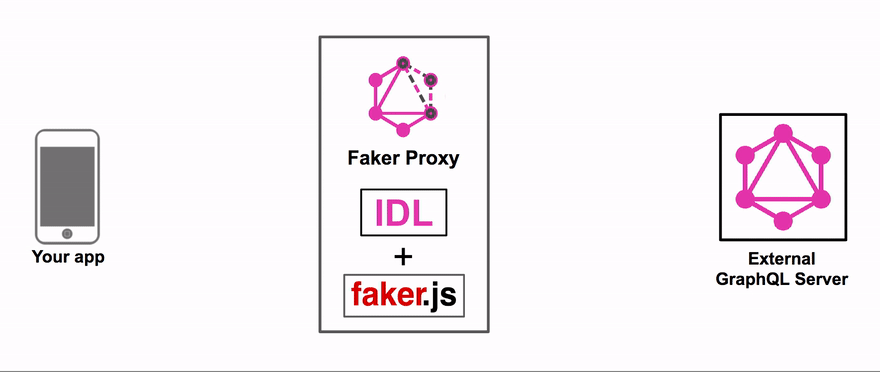Mock your future API or extend the existing API with realistic data from faker.js. No coding required.
All you need is to write GraphQL IDL. Don't worry, we will provide you with examples in our IDL editor.
In the GIF bellow we add fields to types inside real GitHub API and you can make queries from GraphiQL, Apollo, Relay, etc. and receive real data mixed with mock data.

This fork is a major extension of the original library. It has not yet been fully tested. Please help out!
We use @fake directive to let you specify how to fake data. And if 60+ fakers is not enough for you, just use @examples directive to provide examples. Use @sample directive to specify number of returned array items. Add a directive to any field or custom scalar definition:
type Person {
name: String @fake(type: firstName)
gender: String @examples(values: ["male", "female"])
pets: [Pet] @sample(min: 0, max: 8, empty: 0.4)
}
No need to remember or read any docs. Autocompletion is included!
The @sample directive is meant to be used for more fine grained constraints and control such as the range of the number of items to return (ie, min and max for a particular property and the chance for the list to be empty (where 0.4 is a 40% chance).
You can also pass an optional config object as the second argument to fakeSchema with various options for more fine-grained control. See Customization for more details.
- 60+ different types of faked data e.g.
streetAddress,firstName,lastName,imageUrl,lorem,semver - Comes with multiple locales supported
- Runs as a local server (can be called from browser, cURL, your app, etc.)
- Interactive editor with autocompletion for directives with GraphiQL embeded
- ✨ Support for proxying existing GraphQL API and extending it with faked data

npm install -g graphql-faker
or
yarn global add graphql-faker
or run it in a Docker container, see Usage with Docker
Mock GraphQL API based on example IDL and open interactive editor:
graphql-faker --open
Note: You can specify non-existing IDL file names - Faker will use example IDL which you can edit in interactive editor.
Extend real data from SWAPI with faked data based on extension IDL:
graphql-faker ./ext-swapi.grqphql --extend http://swapi.apis.guru
Extend real data from GitHub API with faked data based on extension IDL (you can get token here):
graphql-faker ./ext-gh.graphql --extend https://api.github.com/graphql \
--header "Authorization: bearer <TOKEN>"
graphql-faker [options] [IDL file]
[IDL file] - path to file with IDL. If this argument is omited Faker uses default file name.
-c,--configPath to JSON config file used to load config object-p,--portHTTP Port [default:env.PORTor9002]-e,--extendURL to existing GraphQL server to extend-o,--openOpen page with IDL editor and GraphiQL in browser-H,--headerSpecify headers to the proxied server in cURL format, e.g.:Authorization: bearer XXXXXXXXX--forward-headersSpecify which headers should be forwarded to the proxied server--co,--cors-originCORS: Specify the custom origin for the Access-Control-Allow-Origin header, by default it is the same asOriginheader from the request-h,--helpShow help
When specifying the [SDL file] after the --forward-headers option you need to prefix it with -- to clarify it's not another header. For example:
graphql-faker --extend http://example.com/graphql --forward-headers Authorition -- ./temp.faker.graphql
When you finish with an other option there is no need for the --:
graphql-faker --forward-headers Authorition --extend http://example.com/graphql ./temp.faker.graphql
Using config file faker-config.json
graphql-faker --extend http://example.com/graphql --config ./faker-config.json -- ./temp.faker.graphql
Please note that when using the CLI, you can not pass a custom faker or faker sections since these parts of the configuration require functions. The JSON config file can only contain static config data.
docker run -p=9002:9002 apisguru/graphql-faker [options] [IDL file]
To specify a custom file, mount a volume where the file is located to /workdir:
docker run -v=${PWD}:/workdir apisguru/graphql-faker path/to/schema.idl
Because the process is running inside of the container, --open does not work.
To use the API directly, use the exported run method, passing the relevant options as demonstrated below:
import { run } from "graphql-faker";
const config = {
sample: {
array: {
min: 1,
max: 100
}
}
};
run({
extendUrl: "http://example.com/graphql",
forwardHeaders: "Authorition",
file: "./temp.faker.graphql",
config
});Note: You can also pass the idl as a string to avoid having to load it from a file, such as ./temp.faker.graphql
const idl = `
type Pet {
name: String @fake(type:firstName)
image: String @fake(type:imageUrl, options: {imageCategory:cats})
}
`
run({
extendUrl: "http://example.com/graphql",
idl,
// ...
}const config = {
enable: {
mocking: true,
logging: true
},
//...yarn
npm run build:all
npm run startUses resolve-type-maps to resolve types/field to default values when directives not present
MIT





